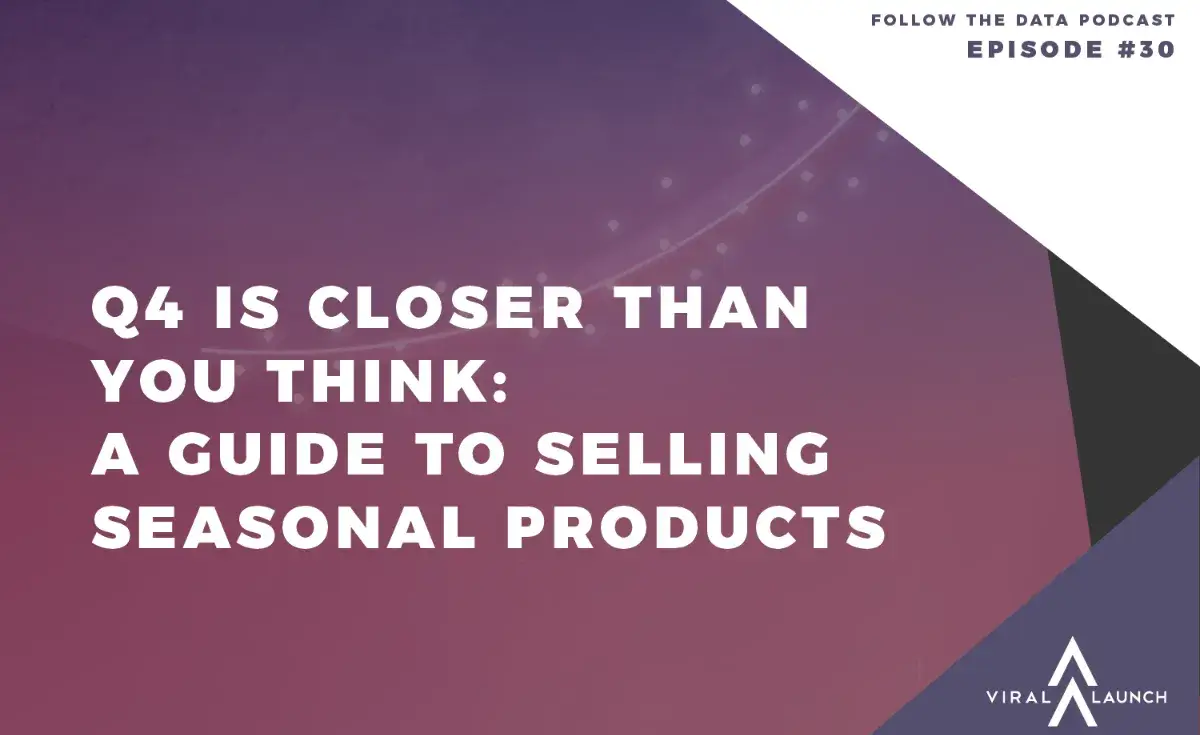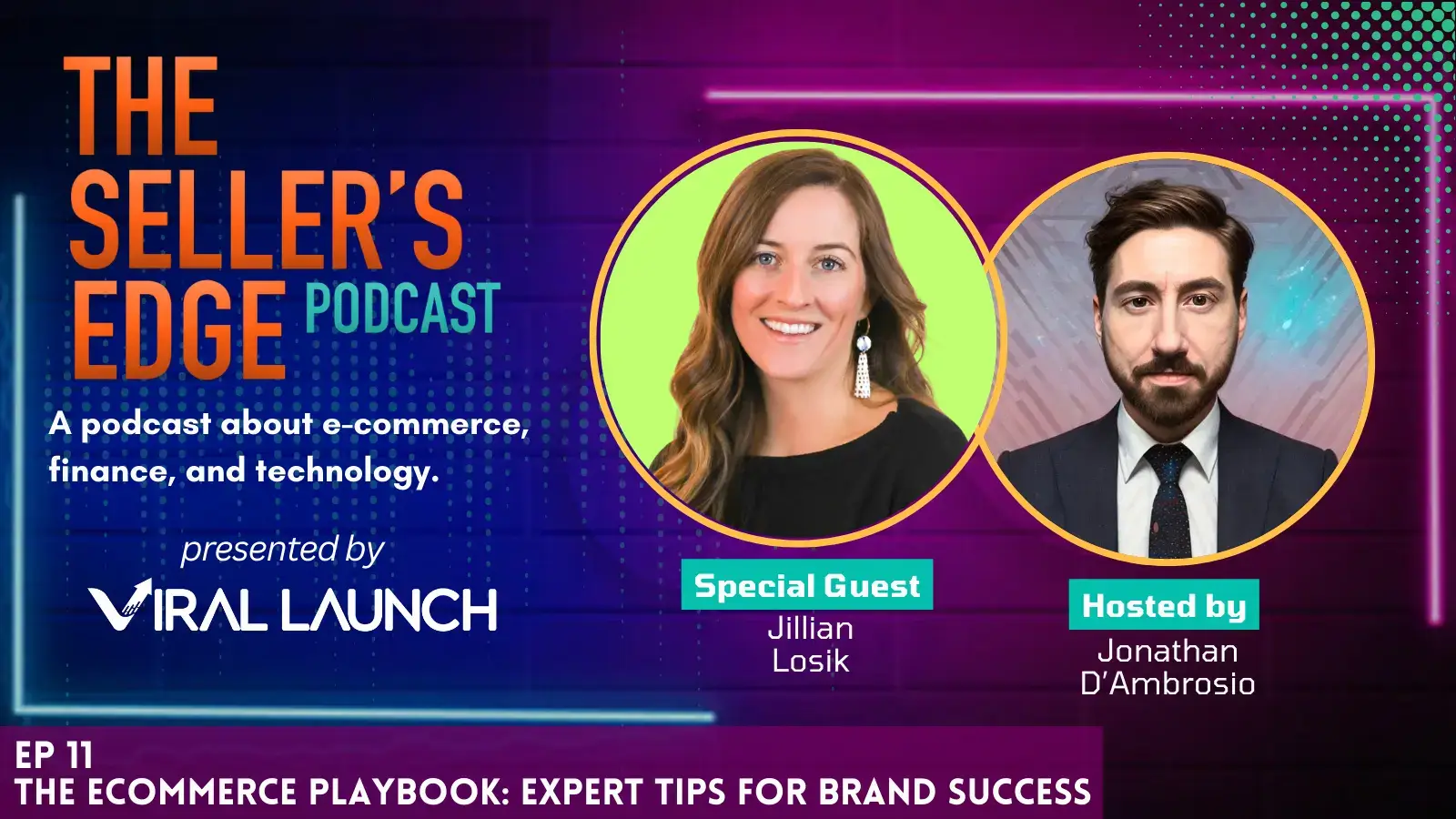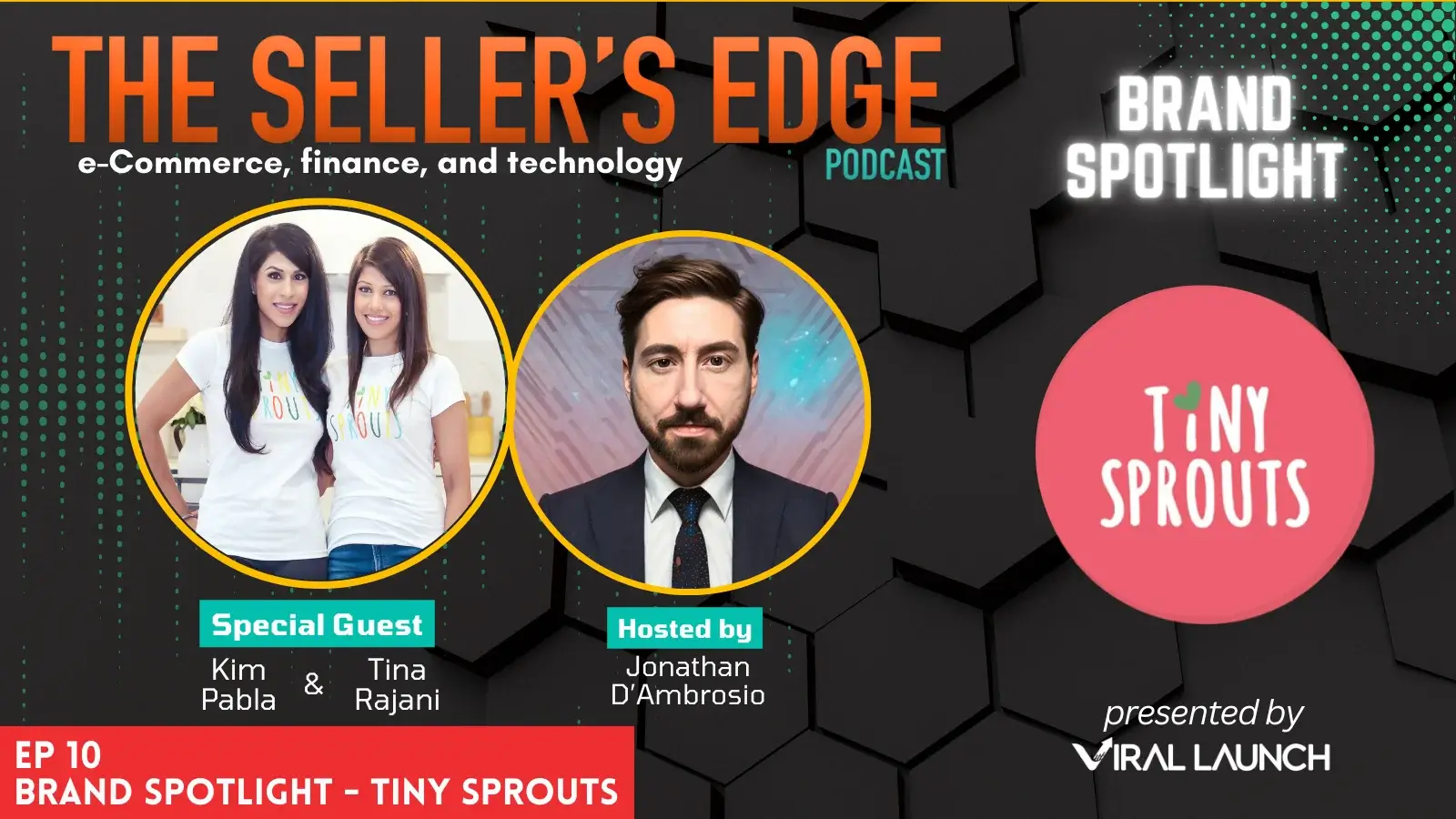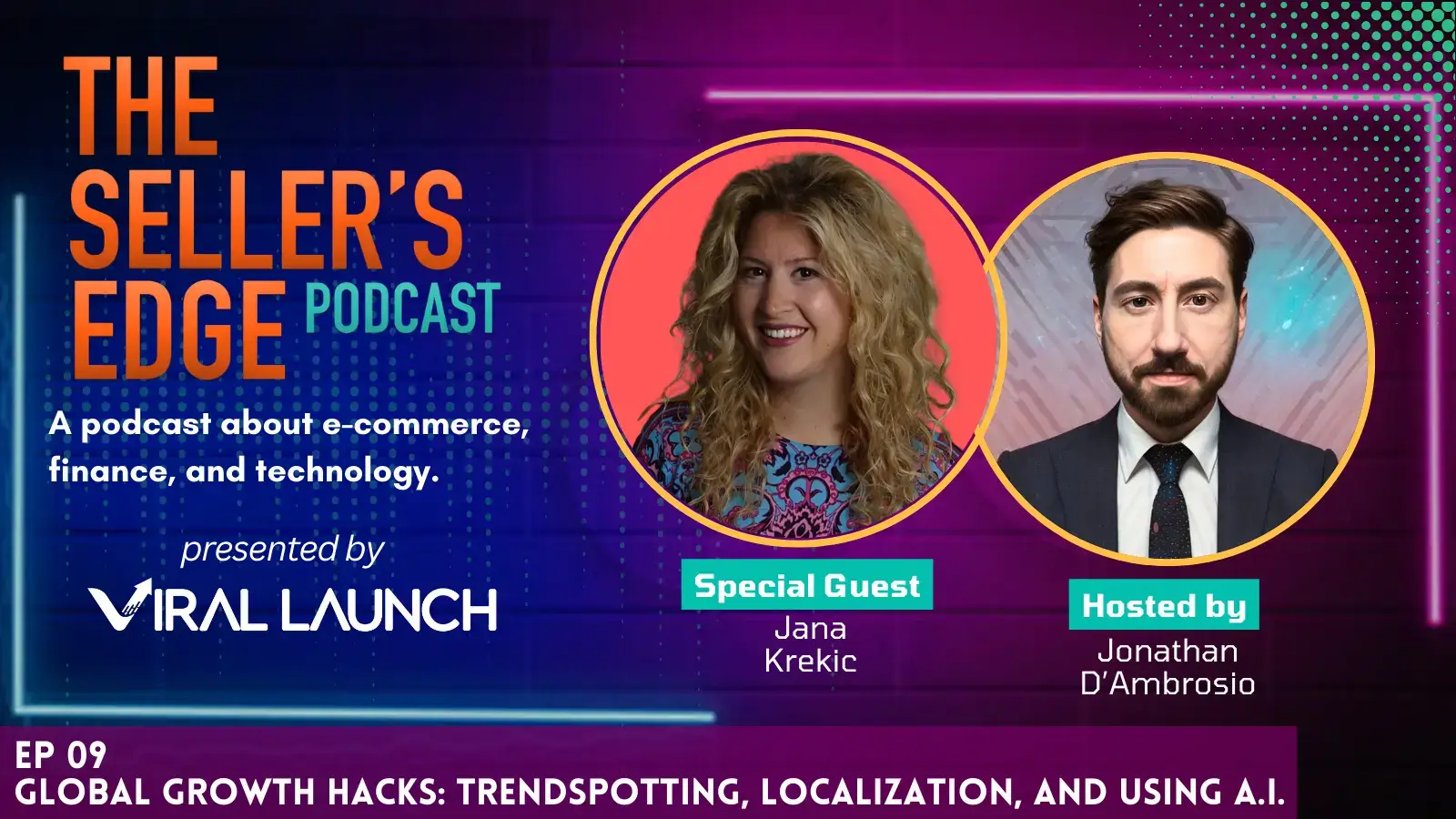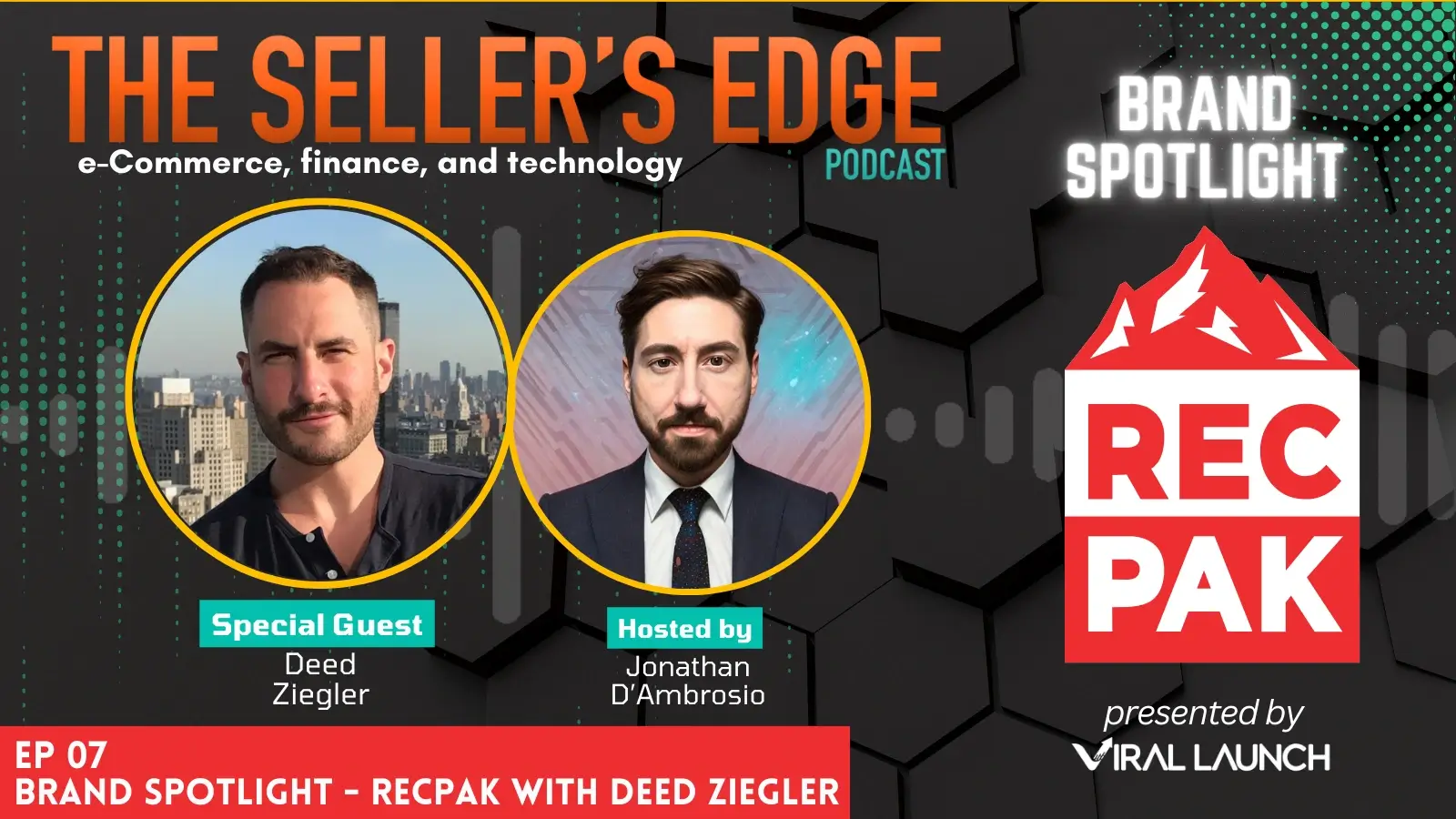Q4 Is Closer Than You Think: A Guide to Selling Seasonal Products (Follow the Data Ep. 30)
It’s never too early to start thinking about Q4. And with Q2 already under way, we’re one quarter closer to the holiday season. As Q4 approaches, you may want to consider sourcing seasonal products. Seasonal products aren’t for everyone, and they certainly aren’t for the faint of heart. But if you choose to take the risk, there’s potential for huge reward.
Show Notes
- Find a seasonal product to sell using Product Discovery. Use filters like Best Sales Period to look at seasonal products to jump on now.
- Serious about planning ahead for Q4 and potential seasonal products? Check out our Q4 Prep Guide.
- Successful seasonal product have successfully written listings. Make sure yours is optimized whether with Keyword Research or a professionally written listing
- Once you have a seasonal product in FBA, you need to get ranking quickly. Set up a launch the right way with the help of an Amazon Seller Coach. Contact one today at [email protected]
- Wondering how Keyword Research works? Let Amazon expert, Cameron Yoder, walk you through the tool.
Podcast Transcript
CAMERON YODER:
Nice.
CASEY GAUSS:
Did you see my fact checking on George from MerchantWords?
CAMERON YODER:
Yeah, I did. That was funny, dude. Come on. Did you put that – yeah, you put that in –
CASEY GAUSS:
The marketing chat.
CAMERON YODER:
– in the marketing chat. That –
CASEY GAUSS:
I’m just a fact checker. BS caller on that.
CAMERON YODER:
[Unintelligible 0:00:17.8] just because no product is selling more than 30 units per month on average. Swinger anklets.
CASEY GAUSS:
Come on.
CAMERON YODER:
Wife. Anklets, oh man.
CASEY GAUSS:
Hot wife anklets. Nobody is searching that, bro.
CAMERON YODER:
Dude. Wait. How did you – oh, no, never mind. That dude –
CASEY GAUSS:
Get the heck out of here.
CAMERON YODER:
Come on, man. Swinger anklets. Are you kidding me? Ugh, man.
CASEY GAUSS:
Good?
CAMERON YODER:
Yeah.
CASEY GAUSS:
Ready?
CAMERON YODER:
Yep.
CASEY GAUSS:
It’s never too early to start thinking about Q4, and with Q2 already underway we’re one quarter closer to the holiday season.
CAMERON YODER:
As Q4 approaches you may want to consider sourcing a seasonal product. Seasonal products aren’t for everyone, and they certainly are not for the faint of heart. But if you choose to – oh, whoa, to the – but if you choose to take the risk there’s potential for huge reward. I’m Cameron Yoder.
CASEY GAUSS:
And I’m Casey Gauss, your hosts for Follow the Data: Your Journey to Amazon FBA Success. In this show we leverage the data we’ve accumulated at Viral Launch from over 30,000 product launches and our experience working with more than 8000 brands to help you understand the big picture when it comes to Amazon and, more importantly, the best practices for success as an Amazon seller.
CAMERON YODER:
In this episode we are going to walk you through the timeline for sourcing a seasonal product using a Q4 example. You’ll see it’s not too early to start your product research if you’re serious about selling a holiday, quote, hotcake. We’ll also talk you through basic inventory planning so you can stay in stock all season and outsell the competition. Let’s get started.
CASEY GAUSS:
Let’s find those hotcakes, Cam.
CAMERON YODER:
Hotcakes. Let’s get us some – let’s get some holiday hotcakes in here. It’s almost comparable to bread.
CASEY GAUSS:
Yeah, no pun intended – pun intended.
CAMERON YODER:
No pun intended, yes.
CASEY GAUSS:
All right. What’s up guys? So Q1 just got done. Early April, you know, it’s like April 10th today, so first third of the first month of the second quarter of the year. So you know, when Cam and Becca came to me with this idea I was like guys, it seems a little bit early for that, but Cam was walking me through kind of the timelines and, you know, I don’t know if we’ve talked about just how great seasonal items can be or, you know, a lot of people – I think a lot of the kind of traditional sourcing gurus say stay away from seasonal products. I 100% understand why. The problem is that there is so much opportunity for seasonal products. We see some guys just absolutely killing it. I don’t have the stats, but there’s this guy, Justin Ligeri. If you want to check him out he claims to be the seller to have the first one million-dollar day. I almost want to say that he had a two million-dollar day, but anyways, he at one point had the largest two-week payout. I mean this guy is just killing it because he focuses, I think, almost exclusively on seasonal items, and it’s because people come in, and they spend an insane amount of money for Halloween. I think that’s his biggest month, or his biggest season. People spend just crazy amounts of money on these seasonal items, and there is so much opportunity. The downside is that it is seasonal, right? So if you are selling Santa hats you’re probably not selling Santa hats very well in July. So if you say, you know, I’m going to sell 500 Santa hats a month and you plan out, you know, six months of inventory, 12 months of inventory, you’re going to be sadly mistaken come, you know, July, June, you know, August or whatever, like when sales aren’t there. So if you are doing this you need to take a very data-driven approach so that you are making the right decisions.
CAMERON YODER:
Yeah, I really think that seasonal products in general – and seasonal does not – also, I don’t want you to necessarily think that seasonal means just in December, or just Christmas, because again, seasonal can mean, or does mean, a spike at really any point in time in the year that’s consistent, that follows a trend.
CASEY GAUSS:
Valentine’s Day-related products.
CAMERON YODER:
Or like Halloween.
CASEY GAUSS:
Pool floats.
CAMERON YODER:
Pool floats, yeah, yeah, Christmas, whatever, something that’s seasonal, spikes consistently at some point in time in the year. Like – seasonal products tend to follow the mantra of like high risk, high reward, right? And in this case you can use data to decrease the risk that you’re taking and really be smart and intentional about your decision. At the same time really the big risk – the goal of a seasonal product, not with everybody, but typically is to have enough inventory in Amazon, get to Page 1 for the primary search terms and sell your inventory during the full period of time, during typically the spike month or spike – whatever period of time that spike is, and then maybe not hold onto that inventory the rest of the year because that’s going to cost you money. So the challenge and the risk becomes ordering enough inventory at the right time, getting in Amazon at the right time, ranking for that item or those items at the right time, and having enough inventory, being in the right spot to capture those spike sales. That is – it’s a lot to think about, and I actually know just like – and Casey you probably know a lot of people that do pretty well with seasonal items. I actually know someone who has been selling seasonally and is actually trying to get out of selling seasonal items.
CASEY GAUSS:
Oh, why is that?
CAMERON YODER:
He is – according to him, he doesn’t really like the stress that comes with it.
CASEY GAUSS:
I see.
CAMERON YODER:
And it takes a lot of – and that’s not to deter you at all it. It just takes – for him, at least, it takes a lot of upkeep. Like he has to be really intentional, and it takes a lot to be intentional about ordering the right amount of inventory or knowing which market to go into. And so this, again like we said from the intro, is not for the faint of heart. However, it can get very profitable for you. And so okay, let’s actually talk through maybe just even the basic timeline of what you should expect when even just starting to think about a seasonal product. So when you’re starting – let’s say – let’s use – if you – actually, if you’re in a good spot to bring out your calendars on your phone, go ahead and bring out your calendar. We’re going to –
CASEY GAUSS:
If you guys are still into the physical calendars, you need to pull that off your wall.
CAMERON YODER:
Desk calendar also.
CASEY GAUSS:
Desk calendars.
CAMERON YODER:
Whiteboard calendars.
CASEY GAUSS:
Pocketbook calendars.
CAMERON YODER:
There are no excuses here. You should be able to find a calendar somewhere. Pull out your calendars. Let’s use December as our, let’s say, peak month. Let’s say we’re going, or we want to source a seasonal item in December, okay? If you’re sourcing a seasonal item in December and you don’t know what that seasonal item is, I am suggesting – we are suggesting that you start thinking about, you start researching seasonal items in April, which is this month, okay, and May. So that means that you should start researching your product, or you should start thinking about sourcing a seasonal product now and over the next – over the next month and over May itself.
CASEY GAUSS:
And I know – I do this as well – I know you’re all thinking. Oh no, I have plenty of time. Seasonal, like Q4 products, you know, really start picking up in December, late November so I have plenty, plenty of time. And if you’re that person I imagine you may have gotten hit with the Chinese New Year and maybe ran out of stock or, you know, maybe you had some issues and missed out on money because of that. Guys, first off, if you are finding the right products it is going to pay off like nothing you’ve ever seen before, hopefully, and anyways, now is the time. This is why we’re having this episode so early.
CAMERON YODER:
You really want a five- to six-month lead time for something like a December, a December-specific seasonal item. Now there are a couple different factors that go into that. Again, one of those is just kind of extended communication with manufacturers. You want to make sure that you’re finding the right product and also shipment times are extended, take a little bit longer leading up to the Christmas month or months just because a large majority of a bunch of sellers are trying to get their inventory into Amazon. So just to clarify, you do want – again, you want that five- to six-month lead time. However, that five- to six-month lead time should be – you want to give yourself basically five to six months before your inventory needs to be in Amazon. And I’m talking like the day that it gets into FBA. And if your – we’re going to speak a lot about in generalities for this episode. Like each market is going to be different, right? However, for most products that peak – most seasonal products that peak in December, typically sales start to pick up from kind of a low trend around October or November, typically maybe the second half of October.
CASEY GAUSS:
It really depends on your product.
CAMERON YODER:
It does. It does. And again, we’re just speaking in general.
CASEY GAUSS:
Candy canes I think pick up like end of September, like early October or something like that.
CAMERON YODER:
Yes, yes, and we’re going to talk about like maybe more specifically how to kind of catch that upswing. But generally let’s just say October is when your products should be in Amazon. So count five months back from October. One, two, three, four, five. That’s May. Six would be April, okay? So April-May is when you should start researching your seasonal products for December in order to get them in in October. So let’s break down – let’s break down these months, okay? April and May. This is what we’re suggesting that you’re performing all of your thought process, your maybe financial – you’re looking at your finances. You’re looking at your finances to see what you’re capable of, and you’re using something like a product research tool like Market Intelligence or Product Discovery to kind of try and find at least a list, or a list of options for products for you to source in December, okay?
June and July, those next two months, these would be basically – these would be months where you are contacting the manufacturers. So in this case you are – you found your products, right, and you’ve gone to something like Alibaba and you try to find a manufacturer for your seasonal product. And again, this is June and July. Ideally, ideally, again, every market is different, right, but ideally by the end of July you would be placing your order, right? And that means that you maybe pay your initial payment on something like Alibaba and you start production for whatever the number is going to be for your seasonal product. And that gives August and September and even some of October as a lead time for your products to be produced and ship, again, by – this is taking sea freight into consideration – and get them into Amazon hopefully by the end of October. And all things considered best case scenario you even maybe get your products in at the beginning of October or even a little bit before that. Like that month, having those products in that month will not hurt you. It’s always – in this case it’s better to have it in as early as possible I think but not too early, and that’s why kind of September and October are good months for you to get your products into Amazon. Once they’re in – oh, go ahead, Casey.
CASEY GAUSS:
Yeah, so the only thing with that is I believe October-something is when they have long-term storage fees. So they’ll really hit you with the storage fees. So like Cam was saying, you absolutely have to make sure that you understand when sales start coming in. And even like, so let’s say it’s at the very beginning of October but you want to, you know, avoid as many of those long-term storage fees as possible. Start using a third-party warehouse. This is something that we’re planning on talking about a bit more here coming up. But anyways, like be really strategic about it. Don’t necessarily just send it into Amazon. This is kind of as a side note. Or let’s say sales really pick up in November but you want to make sure that you’re able to get your inventory in, send it to, you know, a third-party warehouse or something like that.
CAMERON YODER:
There’s actually – a side side note – there actually is another option for people, and you need to check with your manufacturer to see if they can do this. But I know there’s a couple sellers who will produce – they’ll manufacture their items in the manufacturer’s place in China, and the manufacturer will store the items for them for a pretty low fee, or actually for free sometimes –
CASEY GAUSS:
Gotcha.
CAMERON YODER:
– until they need it to ship.
CASEY GAUSS:
Gotcha.
CAMERON YODER:
So if you can do that, I mean just even start that process as early as possible, and – well, whichever makes sense for you. It costs [money 0:13:29.8].
CASEY GAUSS:
Yeah, you also have to think from like capital gain tied up and everything.
CAMERON YODER:
But that’s just another option for you to consider as you’re producing items for seasonal products or even just in general. I know a lot of sellers who do that themselves. So we talked about – we talked about, we talked about – so again, generally, just generally, generally speaking, April this month like right now do your product research. May, do your product research. Maybe start conversations around the end of May, or June, or July, and then get your products ordered around July, maybe the end of July. Have them ship around that time, or like ordered – your order is in. Maybe they’re being manufactured and produced and shipped hopefully right after that period of time to get in around October.
CASEY GAUSS:
Yeah, and a lot of people are like okay, I need to sell the products that are going to kill it in for the Christmas period. What about Thanksgiving? What about October? What about all the other holidays that come through that? What about all the lesser-known holidays that are coming through those times? Like definitely – again, there is so much money to be made for those Christmas sales, but there’s so much money to be made for every other holiday. So just want to keep reminding you not to – like for the example, it’s a lot easier for us to use like Christmas as that example, but there’s so much option – so many options out there.
CAMERON YODER:
It’s really important that you find what you’re lead time is going to be specifically for that product or that market that you’re interested in because that’s going to give you the most accurate representation. But let’s say – let’s go to – let’s talk about ranking.
CASEY GAUSS:
Okay, yeah.
CAMERON YODER:
Let’s talk about ranking. So getting your inventory into Amazon is one thing, but also we want to make sure that you are ranking your product on Page 1 at the opportune time. So Casey maybe talk about like when the most opportune time is for that.
CASEY GAUSS:
Yeah, and the reason we want to kind of talk about this now is one, just so you understand the process; two, so that you understand how easy it can actually be to seize the sales that are coming up because there may be some questions in your mind around like well, you know, will I have enough reviews? Will I actually be ranking by the time the sales come? Like will I miss it? And then, you know, three, we also want to make sure that you are ordering enough inventory so that when it comes time for that season you’re able to run the promotion because you have the inventory necessary to doing it.
So if you take this approach, so I don’t have specific numbers, but I was at an event late December, I believe, CapCon, Capitalism Conference in Austin by Ryan Moran, one of my favorite conferences to go to. Just a lot of my friends or, you know, clients or whatever, are part of that audience. So it’s always cool to catch up with them. But a friend of mine, he’s been selling, I don’t know, for at least a couple of years. He also just spoke at Amazing’s conference. SellerCon is what it was called. Anyways, this guy came to me and he was like dude, your – I had a podcast recently, or I had a podcast right before then, and he’s like dude, your podcast kind of changed my whole Q4. And I was like oh really, why? Like you didn’t tell me that. And it was because we gave him this tip on how to run promotions coming up to Q4, and he like absolutely killed it before. And so it’s very simple concept once you understand it, but if you haven’t thought of it I think we covered it in a different podcast, but essentially what it is is going, using Market Intelligence to see, or some tool where you’re able to see historical sales, where you’re able to see, okay, over the course of a year when does – when do sales really start to spike for this particular keyword or for this particular product? So let’s take candy canes. So yeah, let’s say sales start to increase, you know, in October, but let’s say every year right around the first week of November – let’s say second week of November is when sales really start to spike. So what you need to do is you need to go to November 1st, you know, a week before that, 10 days before that, 12 days before that, and you need to start your promotion. And through that promotion you’re going to be driving extra sales to drive that keyword ranking. And so by that second week of November your product’s ranking at the top of Page 1. And when all that additional traffic starts coming through they’re finding your ASIN. They’re buying it. And now you get to ride that wave of traffic.
And so essentially what we see is you get on top of the wave. You get to ride it up as more and more traffic comes through. You maintain your rank because everyone’s coming and buying yours versus what we see some people do, and I had people come up and say you know they didn’t have that great of a Q4 because they didn’t get their inventory in time – true story – they didn’t get their inventory in time and so they tried to ride, or they tried to swim up from underneath that wave all holiday season, and they just missed out on a ton of sales and spent a lot of money. And what that looks like is they didn’t get their inventory in until the second week of November, third week of November, and sales had already boosted, and now they were running promotions trying to catch up to everybody else. But the sales were so much higher organically than what they were willing to do in their promotion, and it was just a mess.
CAMERON YODER:
Yeah, so the thought process of having inventory in, in this case, by October is, again, generally speaking when those sales for a lot of December-specific products start to increase. And if you have your inventory in by around the middle to end of October, that’s when you have your inventory in. That’s when you start promotions because, like Casey said, when that traffic starts to pick up it becomes more difficult for you to rank in those positions. It takes a little bit more. And the goal here is not to get in too early, and it’s not to get in too late. It’s to get it right at the right time, run a promotion, get to Page 1, and then organically just write it up.
CASEY GAUSS:
Yep.
CAMERON YODER:
And that’s what in this case, again, generally speaking, if you have a seasonal product in December having your inventory in by October or early November, depending on your market, will allow you to start a promotion seven days before that increase to get at the top and to ride the wave up into the heavens.
CASEY GAUSS:
Unfortunately you can’t see Cam demonstrating it with his –
CAMERON YODER:
My hands are – I’m doing a reverse dab right now.
CASEY GAUSS:
Yep. Not to be confused with a reverse ASIN.
CAMERON YODER:
Not the reverse ASIN, but the dab.
CASEY GAUSS:
Oh man.
CAMERON YODER:
What should we talk about? Numbers specifically, do you think we should give exact numbers, number of units? Like what if people are asking –
CASEY GAUSS:
How long has this gone?
CAMERON YODER:
This is 6:14? Oh, dang, I don’t know the time. I think like 20, 20 to 30 minutes I think.
CASEY GAUSS:
Maybe that’s enough just to get people thinking.
CAMERON YODER:
Just to get people to think. Yeah, yeah.
CASEY GAUSS:
Maybe we can just cover like make sure that the – did you already say the trick is to get just enough inventory? You don’t want to get too much?
CAMERON YODER:
Right.
CASEY GAUSS:
Because now you’re stuck?
CAMERON YODER:
I did, but we should iterate – we should reiterate that point.
CASEY GAUSS:
Okay.
CAMERON YODER:
Okay, do you want to do it?
CASEY GAUSS:
Yeah. Yeah, just as a reminder – we can’t put enough emphasis on this – so I think why Cam’s friend he was talking about at the beginning of the episode is so stressed during this period is, again, if you don’t get your inventory in time and you miss out on riding the wave up, you’re going to be left with so much excess inventory because you’re not hitting the sales volume that you were anticipating. So you don’t want that to happen. You also don’t want to order, you know, 1000 units. But you sell through that thousand units a week before the peak season even, or you know, peak sales even get there, meaning you left so much money on the table. So the real trick is using data to understand how much inventory you should have, being able, being willing to plan for a best-case scenario, worst-case scenario, and on both sides. Worst-case scenario that we didn’t order enough inventory, worst-case scenario that we ordered far too much. Then try to figure out what each of those look like. Do some kind of risk/reward calculation. If we order too little inventory, here is what that means. You know, we’re only going to be able to profit, you know, two grand or something for this month, or on this product for that month, or for the season, whatever. If we order to much inventory well, if we order five – let’s say if we order 5000 units we know we can at least sell 3000, but the extra 2000, like that would eat up all of our margin if we’re not able to sell it for the next, you know, couple months. And there’s ways that you can liquidate that to try to get some of your money back. But anyways, really try to figure out what is the goal of this? What do you think is the best-case scenario potential, and trying to work back from there. Okay, we’re okay if we had an extra 500 units, are we okay if we ended up having an extra 1000 units or whatever, so that you understand what kind of risk you should be taking with your inventory.
And, like I said, if you’re taking a data-driven approach, something like Market Intelligence, you can go back and you can look at historical sales. How long did that – when did that spike start? You know, what is kind of the volume underneath that curve? So what were the sales through that peak week and then descending down so oh, it looks like, you know, sellers were selling 5000 units over that brief period of time. So now you know, okay, I should be ordering somewhere around 5000 units, maybe I’ll order 6000 just in case because the margin would absolutely be there. I’d much rather bet on potentially making more than losing the, whatever, money on the thousand units. So anyways, Cam can probably recap better than that.
CAMERON YODER:
No, no, I think that’s good. The bottom line in this episode we just want to get the idea in your guys’ mind to start thinking about Q4, Q4 seasonal products right now because right now is the time to start doing your research if you’re not sure or if you’re not sure which product you want to pick and/or if you had a product last year that might be good this year and/or might not be as good this year. So just start thinking about it. Start doing your research now and really start digging into possible seasonal products for you to source. Oh, I start. Well, that is all for this week. Thank you again so much for joining us here on Follow the Data. For more insights and reliable information on how to succeed on Amazon, subscribe to the podcast and check us out on YouTube.
CASEY GAUSS:
If you’re listening on Apple products please leave us a review and/or rating. Guys, we all know how tough reviews are on Amazon and also how critical they are. Same is true here. Reviews help other people to find our podcast and hopefully give them deeper insights, better data so that they can make better decisions in their Amazon business. If you’re listening on SoundCloud leave us a comment. We appreciate all the feedback for the show and everything that you – dang it.
CAMERON YODER:
That was good.
CASEY GAUSS:
We appreciate all the feedback for the show so much. This show really is for you all, and your input helps us understand how we can do it better at what you guys are looking for, how can we help you essentially.
CAMERON YODER:
And also, if you know a fellow seller who is using suggestions from their keyword tool to determine how many units to give in their launches, send them our way. We want to be a resource for sellers and the information source in this space, so please tell your friends, tell your family, spread the word and share the show.
CASEY GAUSS:
Thanks again for listening, and as always, if you want to be featured on the show, have an Amazon-related question or an idea for an episode, feel free to leave us a voicemail. Our number is 317-721- 6590. Until next time, remember, the data is out there.
CAMERON YODER:
Got ‘em.
CASEY GAUSS:
Kevin David messaged me.
